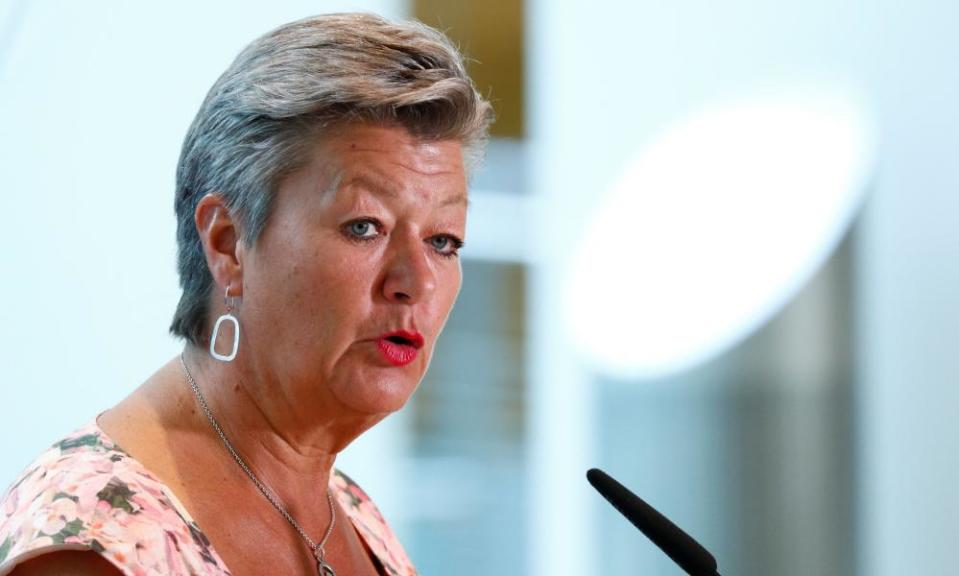EU official says asylum policy impasse 'part of the problem' at Moria

A senior EU official has said Europe’s failure to agree a common migration and asylum policy was partly responsible for the “unacceptable” conditions at the Moria camp on Lesbos that burned to the ground this week, leaving more than 12,000 people without shelter.
Ylva Johansson, the European commissioner for home affairs, said that when she took office in December 2019, the situation for 40,000 refugees and migrants living on Greek islands was “unsustainable and unacceptable”.
Asked whether Moria – long notorious for overcrowded, filthy conditions – was a result of the commission’s past actions, she said: “Migrant camps on Greek soil are primarily the responsibility of the Greek government.”
She added: “The failure [of] the previous commission to actually reach a common European migration and asylum policy is also part of the problem.”
Speaking to the Guardian and other European newspapers, Johansson said: “We sometimes say that Europe does not have a migration crisis, and we don’t have that right now. But some migrants are in crisis and that has been the situation in some of these camps.”

Following the disastrous fire at Moria, the European commission has promised to fund the transfer of 400 lone children to the Greek mainland, and it is sending a ferry to shelter the most vulnerable people.
Johansson highlighted the commission’s actions, working with Athens, to reduce the number of refugees and migrants on the Greek islands, saying the population of Moria had been reduced by almost half in six months: “We were not sitting on our butt to wait for this to happen.”
The Swedish social democrat has been charged with drawing up new migration and asylum rules in an effort to heal the open wound over who takes responsibility for people arriving at Europe’s southern borders. The long-delayed migration and asylum pact due on 30 September will propose how frontline countries such as Greece, Italy and Malta can be better helped by their EU neighbours in managing large numbers of arrivals.
Johansson declined to confirm whether that meant a legally binding obligation on EU countries to take in refugees – an idea behind some of Europe’s most bitter divisions.
She said the problems at Moria were caused “not only” by failure to agree a relocation policy, but also by the absence of swift processes to assess asylum claims and effective means to return people rejected for refugee status to their country of origin.
In 2019 the average asylum seeker in Greece could expect to wait nearly 11 months to get an interview to assess their claim after declaring their intention to seek refugee status, according to the Greek Council for Refugees.
At the height of the migration crisis in 2015, the EU pushed through compulsory refugee quotas in the face of opposition from some central European countries, which flatly refused to shelter asylum seekers. An attempt to reform the system in 2016, based on the idea of mandatory solidarity payments by refusenik countries, foundered.
The commissioner, a former employment and integration minister, also said she would like EU monitoring to prevent illegal pushbacks of asylum seekers at the EU border.
In May, the Guardian found that Malta was using private companies to intercept migrant boats and return potential asylum seekers to Libya. Amid escalating tensions with Turkey, the Greek government was reported by the New York Times to have set up a “black site” where migrants were held without legal recourse before being pushed back into Turkey.
“I am very concerned about reports of pushbacks,” Johansson said. “For me it is a fundamental right to have a right to apply for asylum … and that’s why I am considering introducing a monitoring mechanism in the pact to make sure that people have this right at the borders.” She did not give details on how that mechanism might work.
The migration pact is expected to intensify EU efforts to return failed asylum seekers to their country of origin, as well as proposing legal routes for people seeking to work in Europe. The EU will also put more attention on taking refugees from non-EU countries via resettlement programmes.
The ideas will only come into force with the consent of EU governments. Despite low expectations, Johansson said she was optimistic about finding a compromise on this “very, very difficult exercise”, citing the agreement on the coronavirus recovery plan that had sharply divided member states.
“But I guess when I present my pact, nobody would be happy,” she added.

 Yahoo News
Yahoo News 
